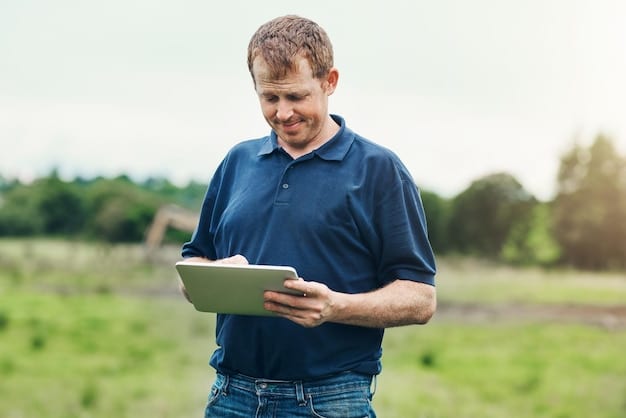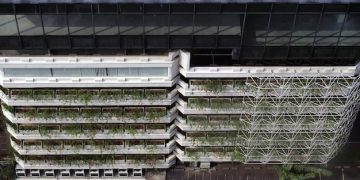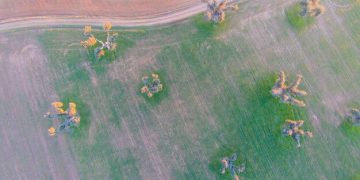Precision Agriculture: US Farmers Save Water with Smart Sensors

US farmers are increasingly adopting precision agriculture techniques, leveraging smart sensors and data analytics to optimize irrigation, resulting in a remarkable 20% reduction in water usage and promoting sustainable farming practices.
The agricultural landscape in the US is undergoing a significant transformation, driven by the adoption of precision agriculture. This innovative approach utilizes technology, including smart sensors, to optimize resource management and enhance crop yields. US Farmers Embrace Precision Agriculture: Reducing Water Usage by 20% with Smart Sensors exemplifies this shift, showcasing how data-driven insights are revolutionizing farming practices.
The Rise of Precision Agriculture in the US
Precision agriculture is no longer a futuristic concept; it’s a present-day reality for many US farmers. The need for sustainable farming practices, coupled with advancements in technology, has fueled its rapid adoption. But what exactly is precision agriculture, and why is it gaining so much traction?
What is Precision Agriculture?
At its core, precision agriculture is about using data and technology to make informed decisions about farming practices. It involves collecting real-time information about soil conditions, weather patterns, and crop health, and then using that information to optimize irrigation, fertilization, and pest control.
The Benefits of Precision Agriculture
The advantages of precision agriculture are numerous, ranging from increased efficiency and reduced costs to minimizing environmental impact. By tailoring inputs to specific needs, farmers can avoid over-application of resources, leading to significant savings and improved sustainability.

- Reduced water usage: Optimized irrigation based on real-time data.
- Increased crop yields: Tailored inputs for maximum productivity.
- Lower input costs: Efficient use of fertilizers and pesticides.
- Environmental sustainability: Minimized resource waste and pollution.
In conclusion, precision agriculture represents a paradigm shift in farming, empowering farmers to make data-driven decisions that benefit both their bottom line and the environment. This approach ensures resources are used efficiently and sustainably, leading to improved yields and a reduced environmental footprint.
Smart Sensors: The Key to Water Conservation
Smart sensors are the backbone of precision agriculture, providing the real-time data that enables farmers to make informed decisions about water management. These sensors come in various forms, each designed to measure specific parameters related to soil moisture, weather conditions, and plant health.
Types of Smart Sensors Used in Agriculture
From soil moisture sensors to weather stations, a variety of smart sensors are employed in precision agriculture. Each type of sensor plays a crucial role in providing a comprehensive picture of the farm environment, enabling farmers to make precise adjustments to their irrigation strategies.
How Smart Sensors Reduce Water Usage
By providing real-time data on soil moisture levels, smart sensors enable farmers to irrigate only when and where it’s needed. This targeted approach eliminates over-watering, leading to significant water savings and improved crop health.
- Real-time soil moisture monitoring.
- Automated irrigation systems.
- Data-driven decision-making.
- Reduced water waste.
Smart sensors are proving to be revolutionary in water conservation for US farmers. By providing the granular data needed to tailor irrigation strategies, these sensors help farmers reduce water usage and improve crop health, creating a more sustainable and efficient agricultural system.
Case Studies: US Farmers Seeing Real Results
The success of precision agriculture and smart sensors isn’t just theoretical; it’s evident in the real-world experiences of US farmers. Numerous case studies demonstrate the tangible benefits of adopting these technologies, including significant reductions in water usage and increased crop yields.
Farmer John’s Story: A Corn Farmer in Iowa
Farmer John, a corn farmer in Iowa, implemented a smart sensor system on his farm and saw a 20% drop in water usage. The data collected by the sensors allowed him to target irrigation to the specific needs of his crops, resulting in a more efficient and sustainable farming operation.
Sarah’s Success: A Vineyard Owner in California
Sarah, a vineyard owner in California, used soil moisture sensors and weather data to optimize her irrigation schedule, decreasing her water footprint by 25%. The combination of real-time data and automated irrigation allowed her to conserve water and improve the quality of her grapes.

- Farmer John reduced water use by 20%.
- Sarah decreased her water footprint by 25%.
- Improved crop yields and quality.
- Increased profitability and sustainability.
The case studies of Farmer John and Sarah showcase the profound effects of precision agriculture in reducing water usage and improving overall farming outcomes. These real-world examples highlight the potential of smart sensors and data-driven strategies to transform agricultural practices across the US.
The Technology Behind Precision Agriculture
Precision agriculture is powered by a range of cutting-edge technologies, including the Internet of Things (IoT), data analytics, and cloud computing. These technologies work together to collect, process, and analyze data, providing farmers with actionable insights that drive informed decision-making.
The Role of IoT in Agriculture
The IoT connects smart sensors and other devices, enabling them to communicate with each other and transmit data to a central platform. This connectivity is essential for collecting real-time information about soil conditions, weather patterns, and crop health.
Data Analytics: Turning Data into Insights
Data analytics tools process the vast amounts of data collected by smart sensors, identifying patterns and trends that can inform irrigation, fertilization, and pest control strategies. These insights help farmers make more precise and effective decisions.
Cloud computing also plays a significant role in precision agriculture, providing the infrastructure needed to store and process large volumes of data. Cloud-based platforms enable farmers to access real-time information and collaborate with experts, regardless of their location.
In conclusion, the technology underlying precision agriculture is complex but effective, combining IoT, data analytics, and cloud computing to deliver valuable insights to farmers. These technological advancements are driving a new era of efficiency and sustainability in agriculture, helping farmers optimize resource use and improve crop yields.
Government Incentives and Support
Recognizing the importance of precision agriculture, the US government offers a range of incentives and support programs to encourage its adoption. These programs provide financial assistance, technical guidance, and research funding to help farmers invest in smart technologies and implement sustainable farming practices.
Financial Assistance Programs
The government offers various financial assistance programs to help farmers purchase and install smart sensors and other precision agriculture equipment. These programs can significantly reduce the upfront costs of adopting these technologies, making them more accessible to farmers of all sizes.
Technical Support and Training
In addition to financial assistance, the government provides technical support and training to help farmers effectively use precision agriculture technologies. These programs offer guidance on data analysis, irrigation management, and other aspects of sustainable farming.
Government support also extends to research and development, funding projects that explore new and innovative ways to improve precision agriculture practices. These research efforts are essential for advancing the field and ensuring that farmers have access to the latest technologies and best practices.
The government’s commitment to precision agriculture fosters innovation and sustainability in the agricultural sector. By providing financial incentives, technical support, and research funding, the government is helping farmers embrace smart technologies and create a more resilient and environmentally friendly food system.
Challenges and Future Trends in Precision Agriculture
Despite its numerous benefits, the adoption of precision agriculture also presents certain challenges. Overcoming these challenges and embracing future trends will be crucial for realizing the full potential of this technology.
Common Challenges Faced by Farmers
One of the primary challenges is the initial cost of investing in smart sensors and other precision agriculture equipment. Additionally, some farmers may lack the technical expertise needed to effectively use these technologies, requiring ongoing training and support.
Future Directions in Precision Agriculture
The future of precision agriculture is bright, with ongoing advancements in technology and increasing focus on sustainability. Innovations like AI-powered analytics, enhanced sensor capabilities, and autonomous farming equipment are poised to transform the industry further.
As technology continues to improve and become more accessible, precision agriculture will play an increasingly important role in ensuring food security and environmental sustainability. By addressing the challenges and embracing future trends, farmers can unlock the full potential of this transformative approach.





